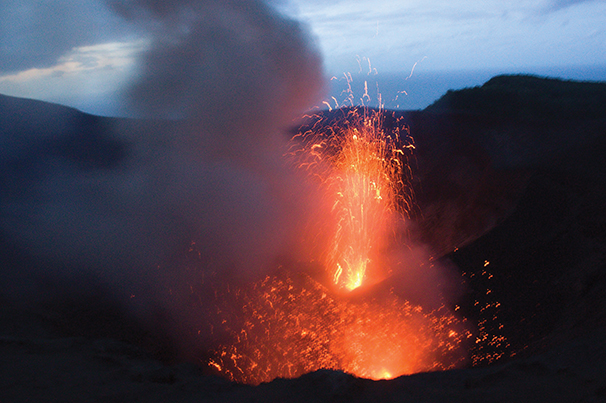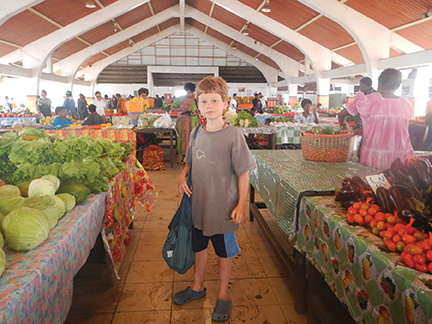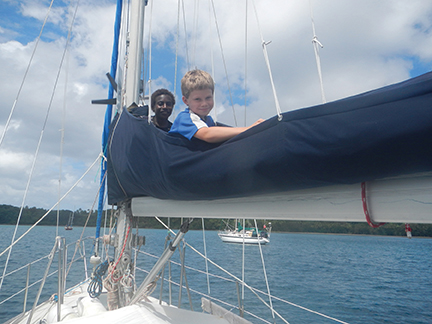Lessons learned in one of the most unique places in the South Pacific (published July 2014)
A Pacific crossing can bring the lucky cruiser to many pockets of paradise. But nowhere did we experience quite the raw, unadulterated version we found in Vanuatu: paradise unplugged. No power, no price tags, no Internet. Lush, green mountains where nature is king. A way of life that is both exotic and accessible. Visiting Vanuatu is like stepping into a photo spread of National Geographic magazine. We saw grass skirts, fierce face paint and fiery volcanoes, all up close and personal. It’s a place where some people worship a bizarre cargo cult and the national newspaper covers allegations of witchcraft in local sports competitions. What’s not to love?

The south end of Vanuatu lies less than 500 miles west-southwest of Fiji, a four day passage for our 35 foot sloop, Namani. Heading for the southern end of the island nation and then working up the chain with the wind is a new privilege for cruisers: previously, customs and immigration could only be completed on Efate, in central Vanuatu. Many sailors skipped the hard slog against prevailing trade winds to the southern islands. As a result, the area doesn’t have a cruised-out feel to it. Nowadays, the police in Anatom offer preliminary clearance. We found ourselves in a happy medium, neither pioneers, nor too late to miss the real thing. As we worked our way north, we could also enjoy the thrill of open ocean sailing in small doses, either in long daily runs or quick overnights—a bonus for the mile-weary Pacific cruiser.

The minute we stepped ashore in Anatom, we realized that Vanuatu is different than its Melanesian neighbors. Our first impression was of a reserved population, particularly in contrast to the outgoing Fijians. Our reception in the village of Anelcauhat was polite but muted; people waved absently and went back to their business, leaving us to go about ours.
Lesson 1: Vanuatu Is Not Fiji. Nor is it New Caledonia, with its paved roads and first-world services. If Fiji made us feel like royalty and New Caledonia made us feel like tourists, the people of Vanuatu made us feel like neighbors. We were left to wander, pursue our own interests and generally observe daily life like over-sized flies on the wall. With time, we were also able to develop closer friendships with individuals, but nowhere else did we find the instant, easy acceptance that southern Vanuatu offered us.
It took us a while to figure all this out, however. On our very first shore expedition on Anatom, we hoped to hike to a distant waterfall. We were a little taken aback when we asked villagers the way.
“Oh, it’s very far,” said the first man, eyes on the ground.
“Um, it’s private land,” said the second, scratching his T-shirt.
“Er, it’s easy to get lost,” added a third, after a pause.
So which was it?
“The spirits could get you.” chipped in a fourth man, genuinely concerned.
That, too?

We were starting to wonder whether they just preferred not to have strangers wandering around their island unaccompanied—a fair enough wish, after all. But then, it clicked. It was all of the above. Vanuatu has a complex belief system that can’t easily be distilled into simple terms for the western mind. And that is part of the appeal: the mystery, the sense of always having something new to learn, no matter how much time you spend there. In that way, Vanuatu is much like sailing itself.
Eventually, we found a guide and thoroughly enjoyed a long day’s outing to the waterfall, as much for the slippery rainforest trail as the cool cascade itself. The guide turned out to be a real bonus (and a fair deal, at US$5 per person). Young Elisha, like his fellow islanders, was reserved at first but more chatty as the day went on, teaching us about local customs and helping us trade for juicy grapefruit, plucked fresh from the tree.
We had spent the previous cyclone season in New Zealand, where outdoor activities are smoothly packaged and peddled. In Vanuatu, a minor tourist economy exists, but it’s all in local, amateur hands. Advertising consists of a guy named Colin in a dugout canoe, inviting you to a roast pig feast. Which brings me to Lesson 2: There Is No Middleman. Doing “business” is like drinking from a pure mountain stream. The water trickles, clear and cool, straight from the source to the throat of the thirsty consumer. Delicious.
Call us slow learners, because it took us a while to catch on to this lesson, too. When Colin first approached with an offer for an evening of feasting and dancing—no hype, no hard sell—we nearly turned him down, feeling a little feasted-out after Polynesia. After all, there is only so much roast pig one can partake of. Or so we thought. The feast/cultural performance described in no-frills terms by Colin turned out to be one of the highlights of our stay. His extended family treated us to a delicious meal after explaining traditional (“Kastom”) dances and costumes. Part of the night was devoted to Kava Drinking 101 (in brief: down-in-one, then “listen” for the effects of the drink). The evening was well worth the US$15 per person, money put toward paying school fees. The family elders see the program as a way of preserving traditional song and dance for the younger generation. It’s a win-win for cruisers and locals alike.
After a day of snorkeling in search of sea turtles and reef sharks off nearby Mystery Island, it was time to weigh anchor and become sailors again. A quick afternoon’s motorsail in the lee of the hills took us to the northern side of Anatom, where we secured the cabin for a brisk 43 mile “passage” north to Tanna the next day. Even after a few days at rest, our sloop gets the look of a gypsy camp—“sailing” mode is very different than “at anchor.” The trip north was a blustery beam reach in 20 knots and six foot seas. Navigation was easy, with a plume of “smoak” (as Captain Cook put it) from Tanna’s volcano guiding us like a beacon. We struck the sails and puttered into Port Resolution, where the great Cook himself dropped anchor—on a bottom that has since been uplifted several feet by tectonic activity. Our chartplotter showed us anchored firmly on land, a clear warning as to the reliability of charts. Lucky for us, there are very few isolated dangers to mind.

Tanna is a lot of things, but to us, it was the island of the most incredible 24 hours of our entire Pacific crossing. Things began on a Thursday at 3 p.m., when a rattling pick-up bounced us over hill, dale and gully to visit the nearby hot spots—literally. First up was a village with steaming hot vents. The people there are members of a fascinating cargo cult set in motion by a mysterious 1936 foreign visitor named Jon Frum (a bizarre story milked to the hilt by Jimmy Buffett in his novel, A Salty Piece of Land).

Next up: Mount Yasur, an active volcano. Very active! We climbed to the crater rim just in time for sunset and a spectacular nighttime sound-and-light show. Our nine year old son called it the scariest and most amazing thing he’s ever seen, and we adults agreed. The earth shook and the mountain roared while the crater spewed cow-sized chunks of orange-red lava into the sky. We were torn between staring into the mesmerizing red glow and fleeing for our lives. Safe? Kind of. Given the number of flip-flop shod tourists who make it home alive every year (entire families, including babies in little snuggle packs, all watching the pretty lava go up and down), it seems safe enough. Our guide assured us that the national park authorities enacted safety measures after two people died there in the early 1990s. Visitors are no longer allowed as far as the rim if activity exceeds a “gentle” level two.
Mount Yasur was a spectacle of nature, and we were privileged to observe its cultural counterpoint early the next morning. A local boy was celebrating his coming of age, and the whole village was invited, including the crews of the eight boats in the bay. Think National Geographic: grass skirts, squealing pigs, ground-stomping dances. A picture is worth a thousand words, and having taken about 500 that morning, I’ll let the shots speak for themselves (page 29). Yes, a bit of western culture has crept in. Women use commercial dyes to color their grass skirts, and the master of ceremonies wore Nikes under his sarong. But those are small distractions, the overall impression is of a timeless ceremony from the far side of the world.
 But our busy social calendar was not yet complete, because we had agreed to a feast at noon. Our hosts, Nelson, Vivian and Lea, explained that while primary education is free in Vanuatu, secondary school is extremely expensive—to the tune of US$500 per student per year. Hence the feasts they offer for a very fair $5, featuring traditional dishes like sticky laplap served on beautifully woven palm leaf plates, not to mention the obligatory roast pig. Did I say tourist economy? Scratch that. These family efforts have more in common with bake sales, as they are honest fundraisers to bring in cash earmarked for a specific purpose. Our hosts were quick to point out that they live well off their lush land and rich seas; their principle cash expenses are education and medicine.
But our busy social calendar was not yet complete, because we had agreed to a feast at noon. Our hosts, Nelson, Vivian and Lea, explained that while primary education is free in Vanuatu, secondary school is extremely expensive—to the tune of US$500 per student per year. Hence the feasts they offer for a very fair $5, featuring traditional dishes like sticky laplap served on beautifully woven palm leaf plates, not to mention the obligatory roast pig. Did I say tourist economy? Scratch that. These family efforts have more in common with bake sales, as they are honest fundraisers to bring in cash earmarked for a specific purpose. Our hosts were quick to point out that they live well off their lush land and rich seas; their principle cash expenses are education and medicine.

By 3 p.m. Friday, we had enough impressions to last a week, and spent the next days decompressing in the familiar comfort of our floating home. It was during that time that we got to know Tom, a quiet local who paddled over asking to borrow tools. It’s not something we do lightly when the nearest Home Depot is roughly 6,000 miles away, but Tom was as good as his word, returning the tools the very next day. In return, Tom invited us to the late afternoon kava hour at the nakamal, the village meeting ground.

That is to say, he invited my husband, Markus; it’s a boy thing. Sorry, ladies, you’ll have to miss out on drinking mud-colored, mildly hallucinogenic liquid chewed and spit out by the two guys over there. Shucks. Markus described it as a hushed, ritual-heavy, Happy-Hour-meets-boy’s-smoking-club and council meeting. After all, people who lack Major League Baseball and sports bars need their own release. Or do we North Americans have MLB and sports bars because we don’t have kava? Lesson 3: It’s All About Perspective.
With our senses stuffed with so many rich impressions, we left Tanna for an overnight sail to the next island, getting spectacular night views of Mount Yasur in action. A crescent moon lay slumbering on its side as we crossed the line of 19 degrees south latitude on our northwest course. Sailing along the windward coast of Tanna was slow and easy, with both wind and seas picking up as we broke into the open channel between islands. A sloppy swell seemed to dominate open water in this part of the Pacific, as it had on the entire passage over from Fiji.

Erromango, to our sensory-satiated relief, was a delightfully subdued experience. Though Dillon Baywas a bit rolly, we enjoyed several days there. They don’t get a lot of cruisers here, but we were warmly greeted by two different villagers in dugout canoes. One, Donald, seemed purely interested in a little outside contact. The other, David, hopes to set up a yacht club on shore—a modest cruiser’s hang-out that would attract more boats if his long-range plan succeeds. It was a delight to make their acquaintance and we feasted for days on the fresh fruit they gave us.
Rather than slopping river water to Namani to do laundry, we joined local women at the river for a washing spree. For us, sitting in the sun surrounded by good company was an unexpected pleasure. Never had our clothes been so clean and never had hand-washing been such a joy.
One of our strangest Vanuatu experiences followed that evening when we made a bonfire on the rocky beach to celebrate the eighth birthday of a cruising buddy. Out of the dark night came five men who peered at us from the shadows. Criminals? Cannibals, even? No, they were just five wetsuit-clad locals, drawn to the light between night dives for lobster. They seemed as fascinated by us and our rituals as we were by theirs, especially when the guitar came out for a few of the kids’ favorites. Our new friends sang along to tunes familiar to all of us, including Frère Jacques and Old McDonald. Sitting under the moon by a bonfire singing E-I-E-I-O with a couple of burly Melanesians qualifies as one of the more surreal—and somehow touching—experiences of our three-year Pacific cruise.
Lesson 4: Embrace Unlikely Encounters, as Markus did the next day when three armed men came out to Namani seeking help with a jammed hunting rifle. In short order, the problem was found and our new friends shown the source of the problem. Wide grins flashed all around.
Erromango also provided Lesson 5: Every Island Is Different. And not just because there are over one thousand local languages. Land rights differ, too. In Anatom, we needed a guide for any walk outside the village. In Tanna, we could wander rough 4WD tracks to our heart’s content, marveling at massive banyan trees and catching glimpses of tropical birds. In Erromango, villagers seemed confused that we even asked permission to walk. Had we taken a full day, we could have hiked as far as the sandalwood forest high in the hills. But with all that laundry, singing, and gun repair, well…

Next stop, the capital “city” of Port Vila on Efate. Throughout the cloudy night, we counted down the 85 miles over rolly seas but made good time with twenty knots of SSE wind. No, there’s no danger of losing your sea legs during your stay in Vanuatu! There must have been something in the night air, because we could see the glow of the capital from 50 miles away. In contrast, we couldn’t pick up on any hint of New York City from that distance when we sailed past some years earlier.
Port Vila showed us the developed side of Vanuatu, with busy streets (cars, even!), shops and a bustling port. The innermost harbor is very deep, so most cruisers take a mooring at Yachting World. There, we could (unenthusiastically) plug back into the outside world, making the most of Internet, local restaurants and services. We thoroughly enjoyed the national museum and its lively custodian, Edgar, who provided a lovely summation of what we had experienced thus far and what still lay ahead. We wanted to go everywhere, see everything: Ambrym, with its carvings, sand drawings, and giant tam-tam drums; Pentecost, home of land-diving; Espiritu Santo with its wreck dives; Epi and its dugongs; the Banks Islands, where few cruisers venture. And that’s just the beginning of the list, all stepping-stones for sailors bound for the Solomon Islands and beyond.

Alas, those heading west, like we were, face a difficult choice. The farther north one sails in Vanuatu, the tighter the wind angle to New Caledonia becomes. That and a prior commitment to meet family had us clearing out in Port Vila and setting a course to the south-southwest. You can’t have it all, but as it was, our senses were near-saturated with so many rich experiences. And who knows? Someday, we might just be back for more.
Nadine Slavinski is the author of Lesson Plans Ahoy: Hands-On Learning for Sailing Children and Home Schooling Sailors. Together with her husband and young son, she cruised the Atlantic and Pacific aboard her 1981 Dufour 35, Namani. She is currently at work on The Silver Spider, a novel of sailing and suspense, as well as Pacific Crossing Notes: A Sailor’s Guide to the Coconut Milk Run (see nslavinski.com for more information and free resources on home schooling).















